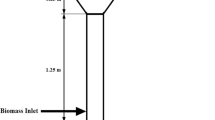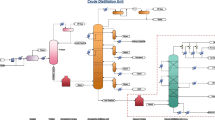Abstract
Generating a reliable experimental model for two-phase compressibility factor in lean gas condensate reservoirs has always been demanding, but it was neglected due to lack of required experimental data. This study presents the main results of constructing the first two-phase compressibility factor model that is completely valid for Iranian lean gas condensate reservoirs. Based on a wide range of experimental data bank for Iranian lean gas condensate reservoirs, a unique two-phase compressibility factor model was generated using design of experiments (DOE) method and neural network technique (ANN). Using DOE, a swift cubic response surface model was generated for two-phase compressibility factor as a function of some selected fluid parameters for lean gas condensate fluids. The proposed DOE and ANN models were finally validated using four new independent data series. The results showed that there is a good agreement between experimental data and the proposed models. In the end, a detailed comparison was made between the results of proposed models.
Similar content being viewed by others
References
A. M. Elsharkawy, Y. S.K. S. Hashem and A. Abbas, Compressibility factor for gas condensates, Alikhan Kuwait University, Paper SPE 59702 (2000).
J. E. Arthur, Essien Consulting Engineers Ltd., China, H. S, Material Balance Modeling and Performance Prediction of a Composite Gas Reservoir, AEC Oil & Gas Co., and, K.O. Temeng, Mobil E&P Services Co, Paper SPE 26194 (1993).
Elsharkawy, Adel M., MB Solution for High Pressure Gas Reservoirs, Petroleum Engineering Department-Kuwait University, Paper SPE 35589-MS (1996).
Elsharkawy, Adel M. and Salah G. Foda, EOS simulation and GRNN modeling of the behavior of retrograde-gas condensate reservoirs, Kuwait University, Paper SPE 38855 (1997).
D.G. Rayes, L. D. Piper, W. D. McCain, Jr. and S.W. Poston, Twophase compressibility factors for retrograde gases; SPE Formation Evaluation, 87 (1992).
R. P. Sutton, Compressibility factors for high-molecular-weight reservoir gases, in 60th Annual Technical Conference and Exhibition of the Society of Petroleum Engineering, Las Vegas, September (1985).
O. A. Osborne, Oil Gas J., 28, 80 (1992).
S. Mohaghegh, R. Arefi, S. Ameri, K. Aminiand and R. Nutter, J. Petroleum Sci. Eng., 16(4), 263 (1996).
C.D. Zhou, X. L. Wu and J. A. Cheng, Determining reservoir properties in reservoir studies using a fuzzy neural network, in 68th Ann. Tech. Meeting, Houston (1993).
R. A. Arehart, Drill bit diagnosis using neural networks, in Artificial Intelligence in Exploration and Production, Texas A&M (1989).
W. J. Epping and G. Nitters, Neural network for analysis and improvement of gas well production, in Computer Simulation Conf, Calgary (1990).
M. F. Briones, G. A. Rojas, J.A. Moreno and E.R. Martinez, Application of neural network in the prediction of reservoir hydrocarbon mixture composition from production data, in 69th Ann. Tech. Meeting, New Orleans (1994).
W. A. Habiballah, R. A. Starzman and M. A. Barrufet, Use of neural networks for prediction of vapor/liquid equilibrium K-values for light-hydrocarbon mixtures, SPE Reservoir Engineering, 121 (1996).
R.B. Gharibi and A. M. Elsharkawy Universal neural network based model for estimating the PVT properties of crude oil systems, in Asia Pacific Conf., Kuala Lumpur, Malaysia (1997).
A. W. Al-Kaabi and J. W. Lee, An artificial neural network approach to identify the well test interpretation model, in 65th Ann. Tech. Meeting, New Orleans (1990).
I.R. Juniardi and I. Ershaghi, Complexities of using neural network in well test analysis of faulted reservoir, in West Reg. Meeting, Alaska (1993).
A.O. Kumoluyi, T. S. Daltaban and J. S. Archer, Identification of well test models using high order neural networks, in European Comp. Conf., SPE 27558, Aberdeen (1994).
W. Sung, I. Yoo, S. Ra and H. Park, Development of the HT-BP Neural Network System for the Identification of a Well-Test Interpretation Model, SPE Computer Applications (1996).
P. Accarian and R. Desbrandes, Neuro-computing help pore pressure determination, Pet. Eng. Int., (1993).
M. Anderson, Design of Experiments, American Institute of Physics (1997).
I. E. Lagaris, A. Likas and D. I. Fotiadis, IEEE Trans. Neural Netw., 9(5), 987 (1998).
O. A. Osborne, Oil Gas J., 28, 80 (1992).
Author information
Authors and Affiliations
Corresponding author
Rights and permissions
About this article
Cite this article
Moayyedi, M., Azamifard, A., Gharesheikhlou, A. et al. Constructing a unique two-phase compressibility factor model for lean gas condensates. Korean J. Chem. Eng. 32, 323–327 (2015). https://doi.org/10.1007/s11814-014-0233-x
Received:
Accepted:
Published:
Issue Date:
DOI: https://doi.org/10.1007/s11814-014-0233-x




